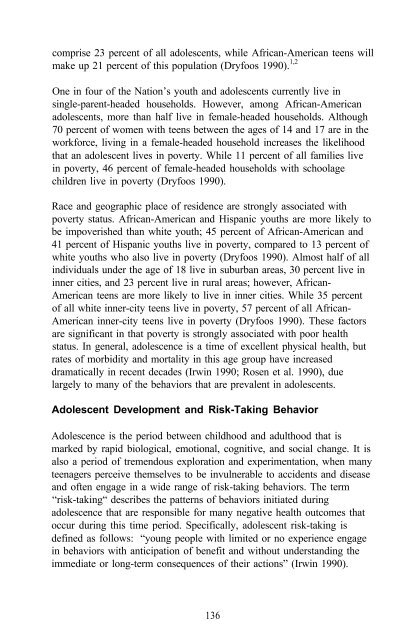The Context of HIV Risk Among Drug Users and Their Sexual Partners
The Context of HIV Risk Among Drug Users and Their Sexual Partners
The Context of HIV Risk Among Drug Users and Their Sexual Partners
You also want an ePaper? Increase the reach of your titles
YUMPU automatically turns print PDFs into web optimized ePapers that Google loves.
comprise 23 percent <strong>of</strong> all adolescents, while African-American teens will<br />
make up 21 percent <strong>of</strong> this population (Dryfoos 1990). 1,2<br />
One in four <strong>of</strong> the Nation’s youth <strong>and</strong> adolescents currently live in<br />
single-parent-headed households. However, among African-American<br />
adolescents, more than half live in female-headed households. Although<br />
70 percent <strong>of</strong> women with teens between the ages <strong>of</strong> 14 <strong>and</strong> 17 are in the<br />
workforce, living in a female-headed household increases the likelihood<br />
that an adolescent lives in poverty. While 11 percent <strong>of</strong> all families live<br />
in poverty, 46 percent <strong>of</strong> female-headed households with schoolage<br />
children live in poverty (Dryfoos 1990).<br />
Race <strong>and</strong> geographic place <strong>of</strong> residence are strongly associated with<br />
poverty status. African-American <strong>and</strong> Hispanic youths are more likely to<br />
be impoverished than white youth; 45 percent <strong>of</strong> African-American <strong>and</strong><br />
41 percent <strong>of</strong> Hispanic youths live in poverty, compared to 13 percent <strong>of</strong><br />
white youths who also live in poverty (Dryfoos 1990). Almost half <strong>of</strong> all<br />
individuals under the age <strong>of</strong> 18 live in suburban areas, 30 percent live in<br />
inner cities, <strong>and</strong> 23 percent live in rural areas; however, African-<br />
American teens are more likely to live in inner cities. While 35 percent<br />
<strong>of</strong> all white inner-city teens live in poverty, 57 percent <strong>of</strong> all African-<br />
American inner-city teens live in poverty (Dryfoos 1990). <strong>The</strong>se factors<br />
are significant in that poverty is strongly associated with poor health<br />
status. In general, adolescence is a time <strong>of</strong> excellent physical health, but<br />
rates <strong>of</strong> morbidity <strong>and</strong> mortality in this age group have increased<br />
dramatically in recent decades (Irwin 1990; Rosen et al. 1990), due<br />
largely to many <strong>of</strong> the behaviors that are prevalent in adolescents.<br />
Adolescent Development <strong>and</strong> <strong>Risk</strong>-Taking Behavior<br />
Adolescence is the period between childhood <strong>and</strong> adulthood that is<br />
marked by rapid biological, emotional, cognitive, <strong>and</strong> social change. It is<br />
also a period <strong>of</strong> tremendous exploration <strong>and</strong> experimentation, when many<br />
teenagers perceive themselves to be invulnerable to accidents <strong>and</strong> disease<br />
<strong>and</strong> <strong>of</strong>ten engage in a wide range <strong>of</strong> risk-taking behaviors. <strong>The</strong> term<br />
“risk-taking“ describes the patterns <strong>of</strong> behaviors initiated during<br />
adolescence that are responsible for many negative health outcomes that<br />
occur during this time period. Specifically, adolescent risk-taking is<br />
defined as follows: “young people with limited or no experience engage<br />
in behaviors with anticipation <strong>of</strong> benefit <strong>and</strong> without underst<strong>and</strong>ing the<br />
immediate or long-term consequences <strong>of</strong> their actions” (Irwin 1990).<br />
136
















